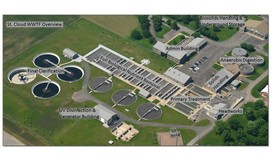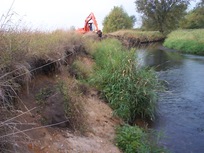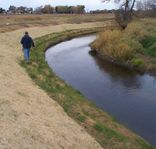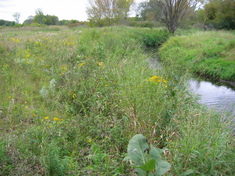|
April 2015

The project
team for the Nutrient Recovery pilot at the St. Cloud Wastewater Treatment Facility included, from
left, Shane Lund, Brian Schoenecker, Erin McMahon, Tracy Hodel, Lisa
Vollbrecht, Emma Larson, Wayne Ethen, Patrick Shea and Scott Schaefer (AE2S). (Photo
courtesy of St. Cloud WWTF)

Harvesting phosphorus
for fertilizer from a wastewater side stream shows promise according to a recent
pilot project at the St. Cloud Wastewater Treatment Facility (photo at right).
The facility receives 10 million gallons a day of wastewater
from the cities of St. Cloud, St. Joseph, Sartell, Waite Park, Sauk Rapids and
St. Augusta. It received a Clean Water, Land and Legacy grant to test nutrient
recovery, an emerging technology in wastewater treatment.
Harvesting
nutrients offers several benefits, including:
-
Removing a form of phosphorus that can lead to problems in the treatment process. Magnesium ammonium phosphate – also called struvite – can cause significant operational issues when precipitation is uncontrolled.
- Achieving nutrient limits to help lakes and rivers. Removing the phosphorus can help treatment plants reduce the nutrient level in their discharge to surface waters where phosphorus can cause algal blooms.
- Meeting the demand for farm fertilizers. Harvesting the phosphorus for fertilizers
helps agriculture because the world is depleting its available amount of
phosphorus.
For
the pilot project, the city of St. Cloud and its consultant, Advanced
Engineering and Environmental Services (AE2S), tested harvesting struvite from
the biosolids supernatant to help maintain effluent phosphorus at the current
concentration of 0.3 mg/L. After trial and error, the project team used a precipitation
process to harvest useable phosphorus from the biosolids supernatant. The
project showed that struvite can be harvested from biosolids waste streams with
some modifications to the waste streams.
For
additional information about this project please contact Bruce Henningsgaard at
the MPCA at 651-757-2427 or bruce.henningsgaard@state.mn.us, or Emma Larson at
the city of St. Cloud at 320-255-7226 or emma.larson@ci.stcloud.mn.us.
The
pilot project will also be the subject of a Mississippi River Forum. "No such thing as wastewater:
St. Cloud's innovations in resource recovery," will be presented on
Friday, April 24 from 8-9:30 a.m. in St. Cloud and Friday, June 19 from 8-9:30
a.m. in Minneapolis. See the forum webpage for more information.
|
MPCA working to resolve calculator inaccuracies

Based on comments from permit holders and from MPCA enforcement
staff, the agency has found that its eDMR calculations are not always accurate. It
appears that maximum calendar week average values for CBOD and TSS may
sometimes be calculated incorrectly, especially for permits that require
twice-per-month sampling. There may be problems with other maximum calculations
too.
Because the problems occur randomly, they require more investigation to
resolve. MPCA’s priority at this time is testing and preparing the new eDMR and
calculator services. Because of this priority, corrections to existing services
may take additional time.
Until the MPCA announces that the existing calculations are fixed, the agency
urges you to review the results of all MPCA calculations to ensure you report
valid numbers on your eDMR. Also, be sure to look at the calculated values to
ensure they make sense. For example, if the pH is calculated as 20, that can’t
be correct.
|
Entities with permits for non-metallic mining should be
aware of new sampling requirements if they have dewatering discharges. For
parties with coverage under the MNG490000 Nonmetallic Mining and Associated
Activities General Permit, the 2016 permit reissuance process will
require additional monitoring data of dewatering discharges.
The sampling and analysis of additional parameters is
required prior to permit expiration and should be submitted with application
for permit re-issuance. Permit applications for the next reissuance will be due May 4, 2016. Because the application deadline is in late
spring, sampling and analysis of dewatering discharges may be difficult depending on weather conditions. The MPCA advises doing the
additional dewatering monitoring requirements this year.
Applications submitted without this required monitoring data
will be considered incomplete. Please see part 8.20, page 20, of the MNG490000
permit for the specific list of parameters and other details.
If you have any questions, please contact Theresa Haugen at theresa.haugen@state.mn.us or
218-316-3920.
The MPCA thanks all
the presenters and 600-plus attendees at the 78th annual Wastewater Operations
Conference March 25-27 in Brooklyn Park.
Congratulations to the 120-some Wastewater Treatment Facilities that received Operational Awards for outstanding operation, maintenance and management practices at their facilities in 2014. And congratulations to the operators who received the awards on their facility’s behalf. The awards are based on a
facility demonstrating full compliance with MPCA operating permits. They also
require that facilities are overseen by properly certified operators; all
required monthly and annual reports are timely and properly completed; and
facilities have no unauthorized releases or bypasses, enforcement actions or inspections identifying
compliance issues.
Look
for the list of winners to be posted soon on the MPCA
website.
|
Nominees for Environmental Initiative Awards include a sustainability project at the Empire Wastewater Treatment Plant - Metropolitan Council Environmental Services (MCES) on the Vermillion River in theTwin Cities metro area.
Thanks to partners and volunteers, the project included, according to the Environmental Initiative:
- Stabilizing 1,200 feet of severely eroded streambank;
- Installing “lunker boxes” in a stream to provide trout habitat;
- Restoring a 50-acre wet meadow wetland;
- Removing invasive buckthorn vegetation from the floodplain; and
- Enhancing species and plant diversity in a 34-acre grassland.
|
|
 |
|
In addition, when the MCES-Empire WWTP expanded from 2004 to 2007, the facility relocated its effluent conveyance pipe to divert treated wastewater from the environmentally sensitive Vermillion River. The expansion also included many low impact development improvements designed to achieve zero runoff in rainfall events:
- A green roof;
- Permeable pavers;
- Infiltration basins; and
- Recycling treated wastewater for use in other WWTP processes.
|
|
 |
 The project has resulted in increased diversity of birds and other wildlife at the site, improved water quality and presence of fish in the state-designated trout stream, and achievement of zero runoff after rainfalls of up to 5 inches contributing to replenishment of groundwater resources.
For more information, read about the project on the Environmental Initiative website.
Top
photo: Streambank at start of stabilization. Middle photo: Streambank during
the restoration work. Bottom photo: Fully restored streambank flourishing with
plants. Photos courtesy of Karen Schik/Friends of the Mississippi River
|
“ 'Flushable'
wipes can cost thousands to fix clogged pipes” in the StarTribune
“San
Francisco plan requires new buildings to recycle water” in the Pioneer
Press
“A
drop in the bucket, a hit to the wallet” in the Duluth News Tribune
“Water
Works winter nitrate costs: $540,000” in the Des Moines Register
“For
the love of water, become a volunteer monitor today” on the MPCA website
“Governor’s Jobs Bill Would Create 23,900
Minnesota Jobs ”
(includes $21.6 million for wastewater infrastructure projects in Tracy,
Grove City, Clarissa, Wauburn, Brownton, Hoffman, Lakefield, and other
communities around the state) on the Gov. Mark Dayton website
|